Oral health in children with sleep-disordered breathing: a cross-sectional study
Keywords:
sleep-disordered breathing, oral health, quality of life, childrenAbstract
Sleep-disordered breathing (SDB) is associated with a wide range of oral manifestations, including adeno-tonsillar hypertrophy, narrow dentoalveolar width, increased overjet, reduced overbite, and malocclusion. There are no studies about the relationship between SDB and poor oral health in the pediatric population. The aim of this study was to investigate oral health status and oral health-related quality of life (OHRQoL) in children at risk of SDB (SDB+), compared with a control group, not at risk for SDB (SDB). The current cross-sectional study recruited consecutive children, aged between 8 and 17 years, from a university-based dental clinic. Caregivers completed the Pediatric Sleep Questionnaire (PSQ) to stratify risk of SDB. Both children and caregivers completed the Child Oral Health Impact Profile (COHIP) to measure the OHRQoL. A dental exam was conducted to evaluate dental caries, periodontal status, oropharyngeal characteristics, and dental occlusion. DMFS (decay-missing-filled for permanent teeth), dmfs (for primary teeth), PPD (pocket probing depth), parent COHIP score, child COHIP score, and BOP (bleeding on probing) were compared between children SDB+ and SDB-. In this study, 122 children were enrolled and divided into two equal subgroups (61 each). There was a significant association between SDB and all six outcomes (all p < 0.05) with higher values in SDB+ children. SDB+ was associated with a poorer OHRQoL, and a greater COHIP score for both parents and children. In conclusion, the current study suggests that the impact of SDB on oral health and OHRQoL in children is relevant and far-reaching. Therefore, it is necessary to closely monitor the oral health of SDB+ children, and, if appropriate, to use gentle non-pharmacological treatments able to reduce nasal congestion.
Downloads
Published
Issue
Section
License
This is an Open Access article distributed under the terms of the Creative Commons Attribution License (https://creativecommons.org/licenses/by-nc/4.0) which permits unrestricted use, distribution, and reproduction in any medium, provided the original work is properly cited.
Transfer of Copyright and Permission to Reproduce Parts of Published Papers.
Authors retain the copyright for their published work. No formal permission will be required to reproduce parts (tables or illustrations) of published papers, provided the source is quoted appropriately and reproduction has no commercial intent. Reproductions with commercial intent will require written permission and payment of royalties.






